2016 | OriginalPaper | Buchkapitel
Patch-Based Hippocampus Segmentation Using a Local Subspace Learning Method
verfasst von : Yan Wang, Xi Wu, Guangkai Ma, Zongqing Ma, Ying Fu, Jiliu Zhou
Erschienen in: Machine Learning in Medical Imaging
Aktivieren Sie unsere intelligente Suche, um passende Fachinhalte oder Patente zu finden.
Wählen Sie Textabschnitte aus um mit Künstlicher Intelligenz passenden Patente zu finden. powered by
Markieren Sie Textabschnitte, um KI-gestützt weitere passende Inhalte zu finden. powered by
